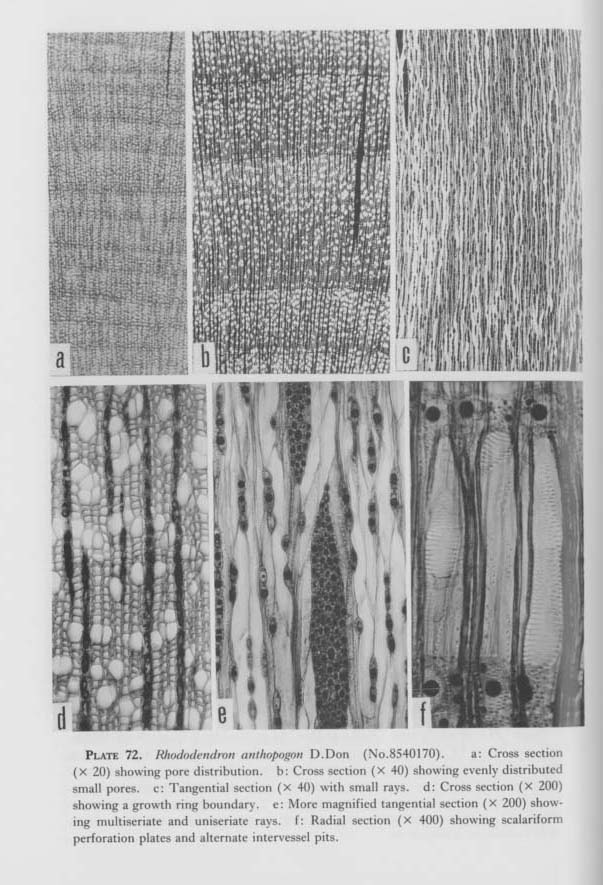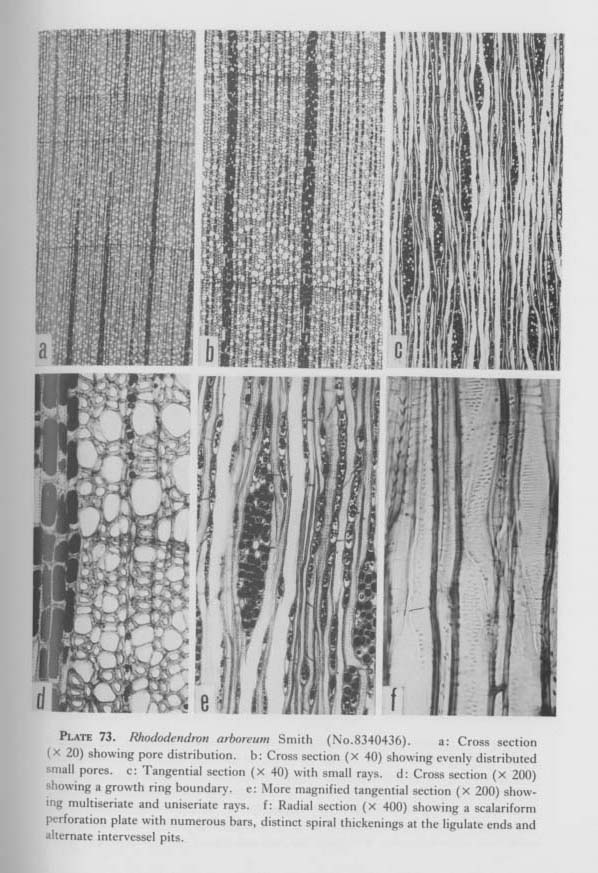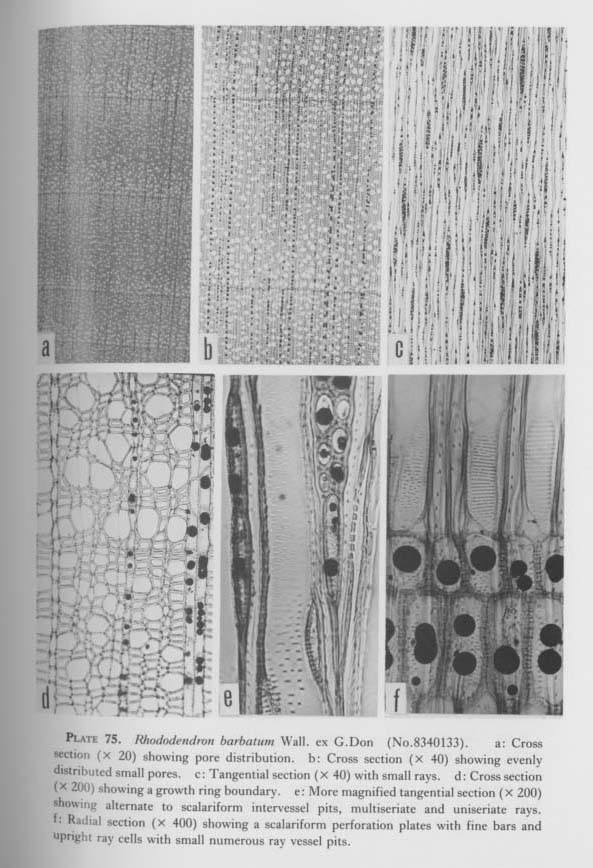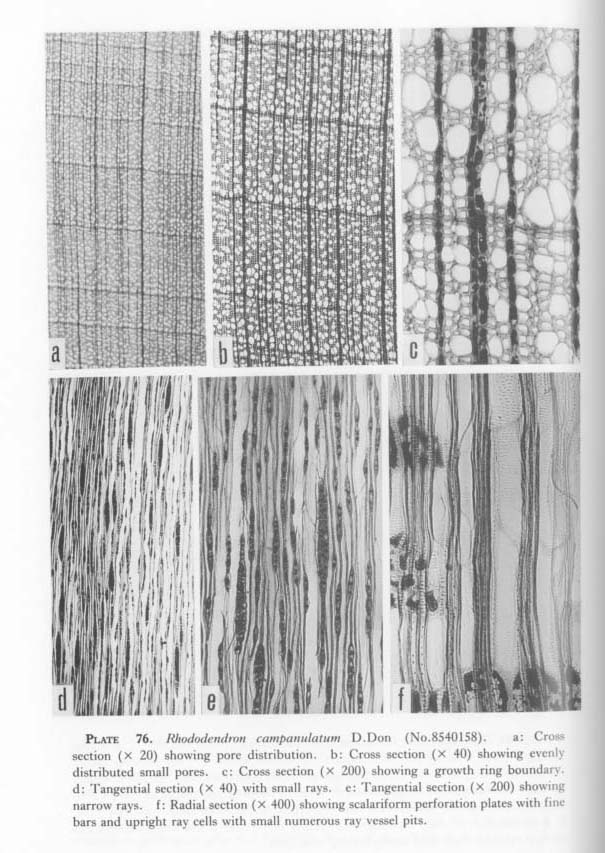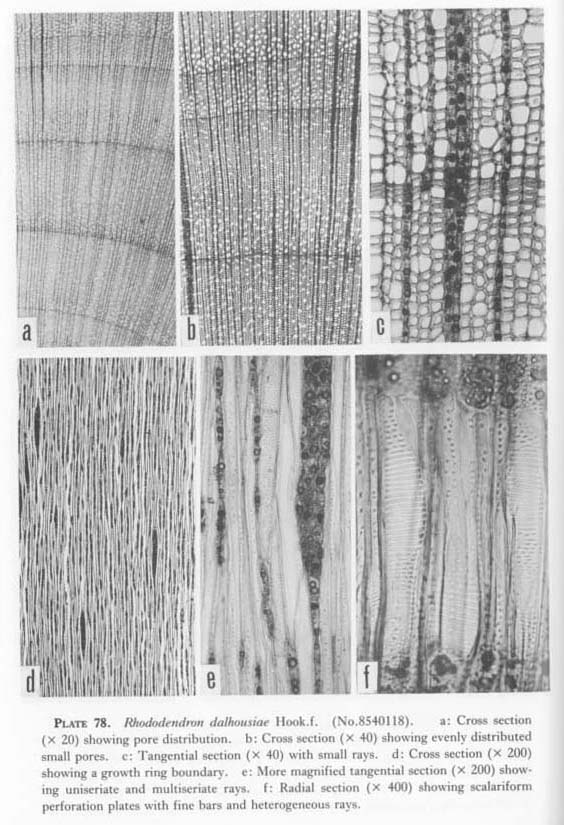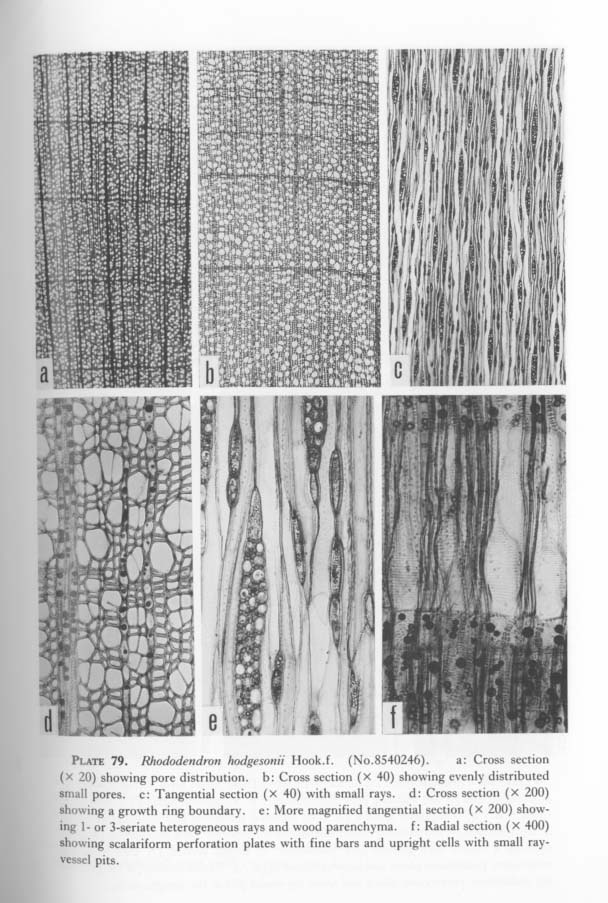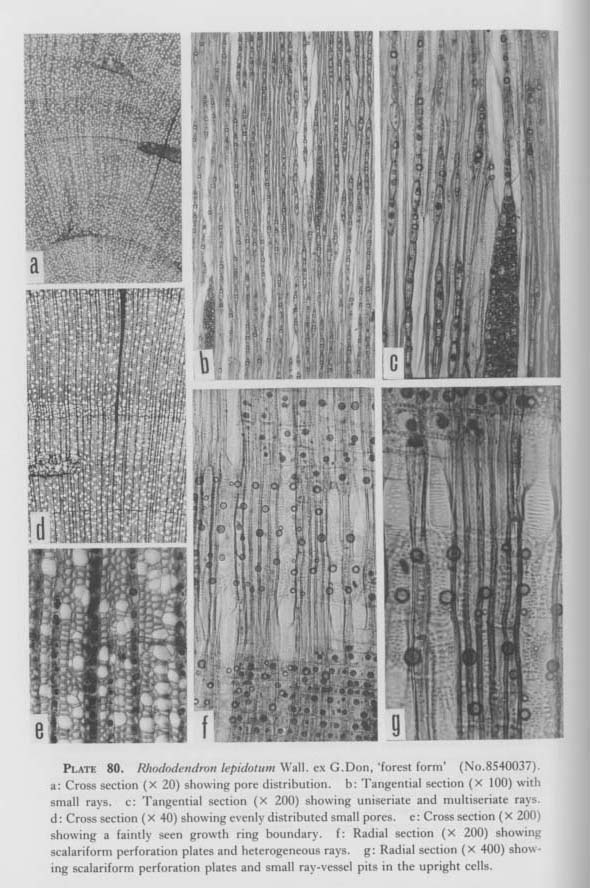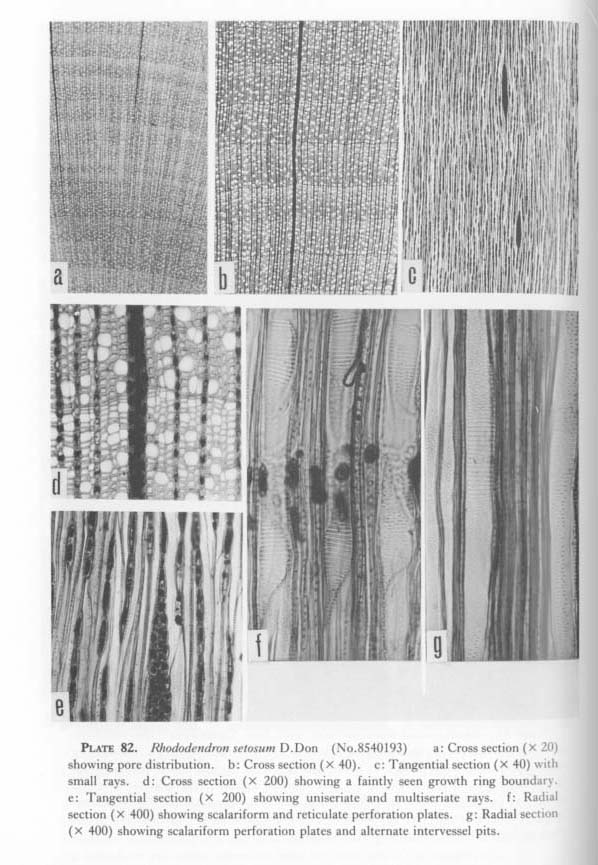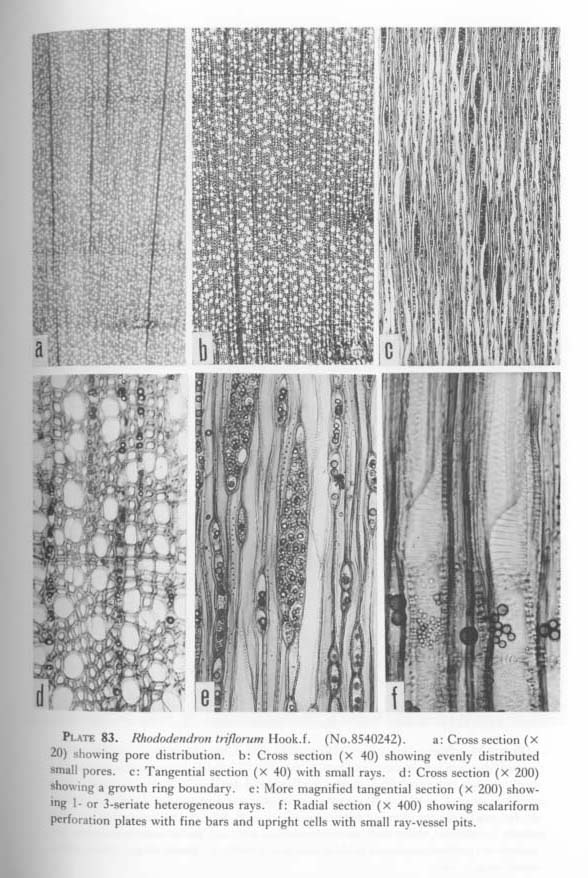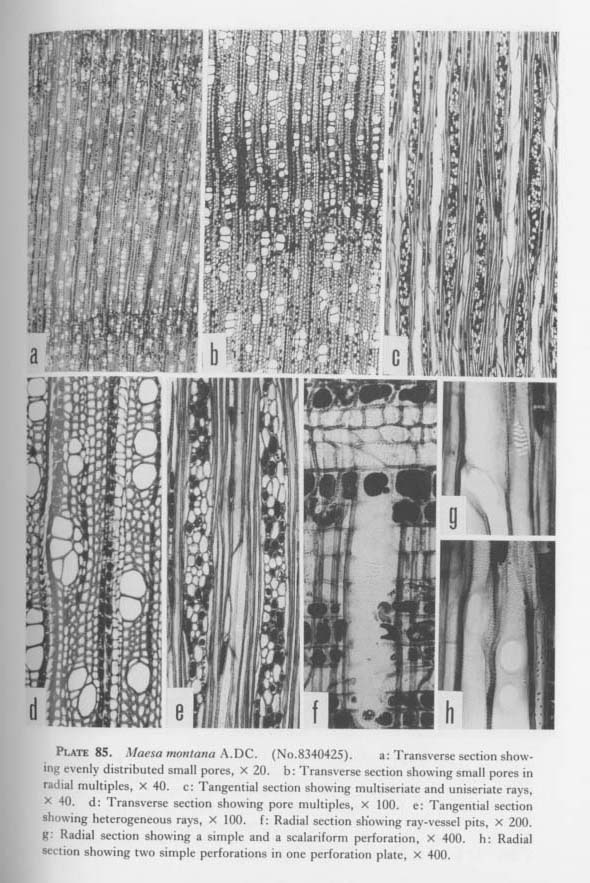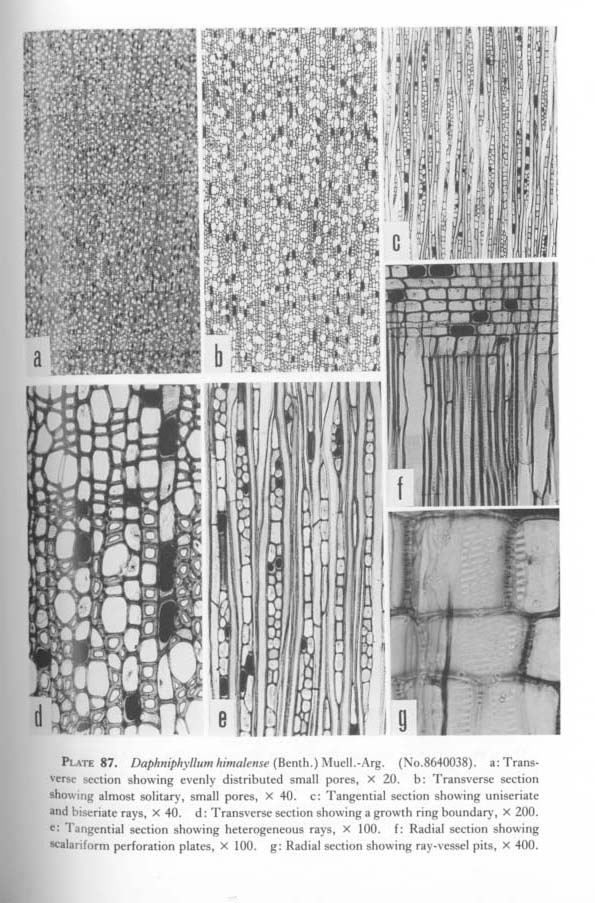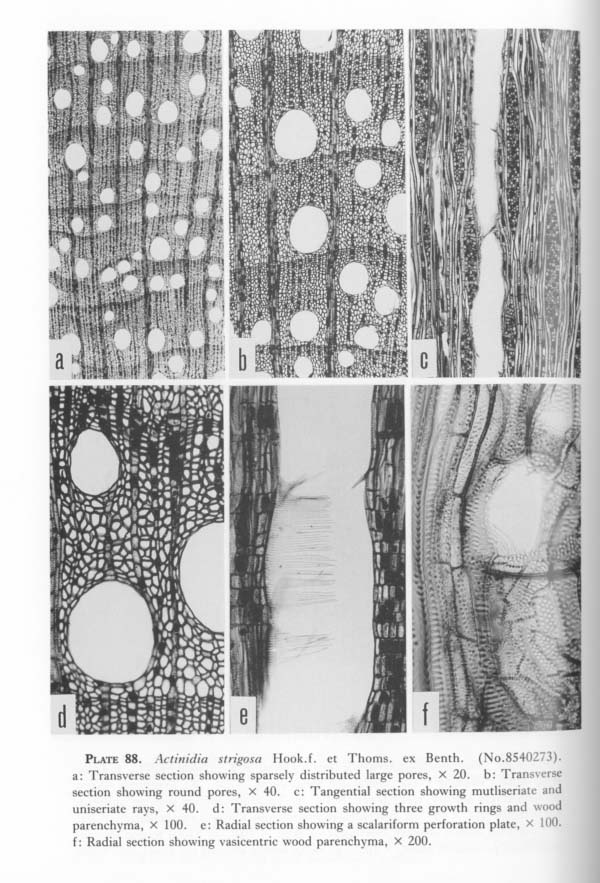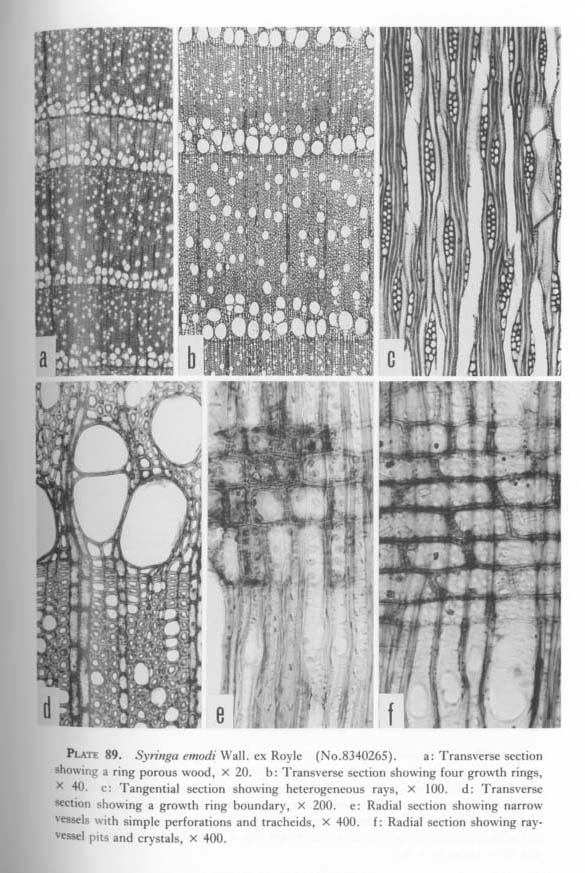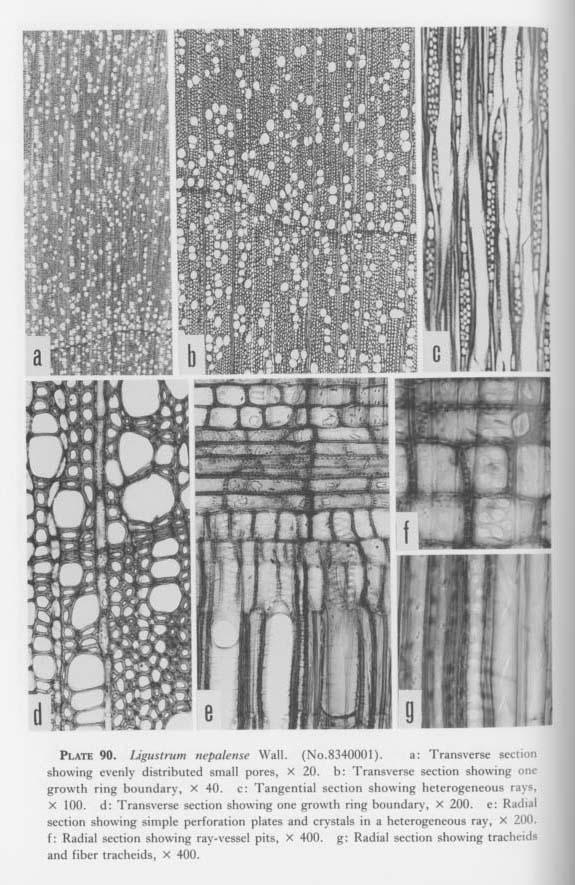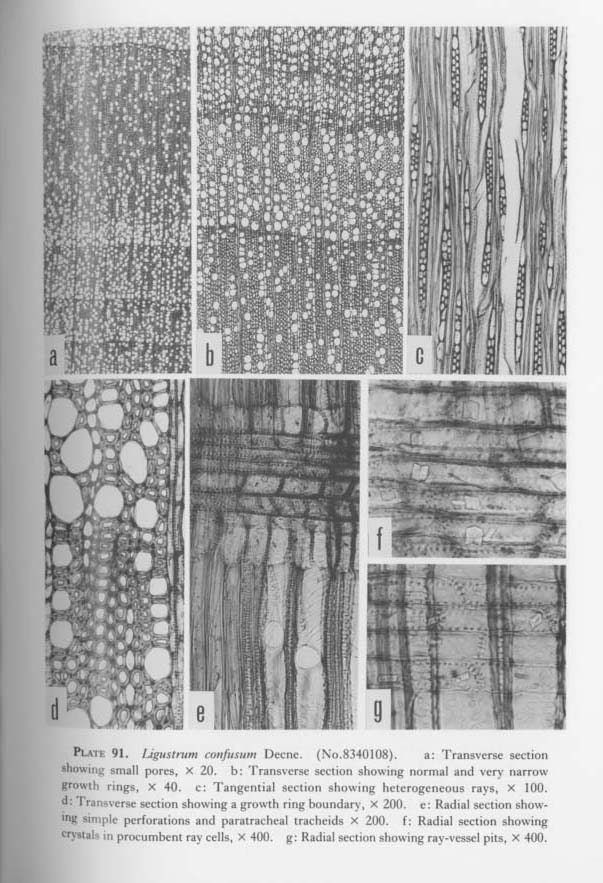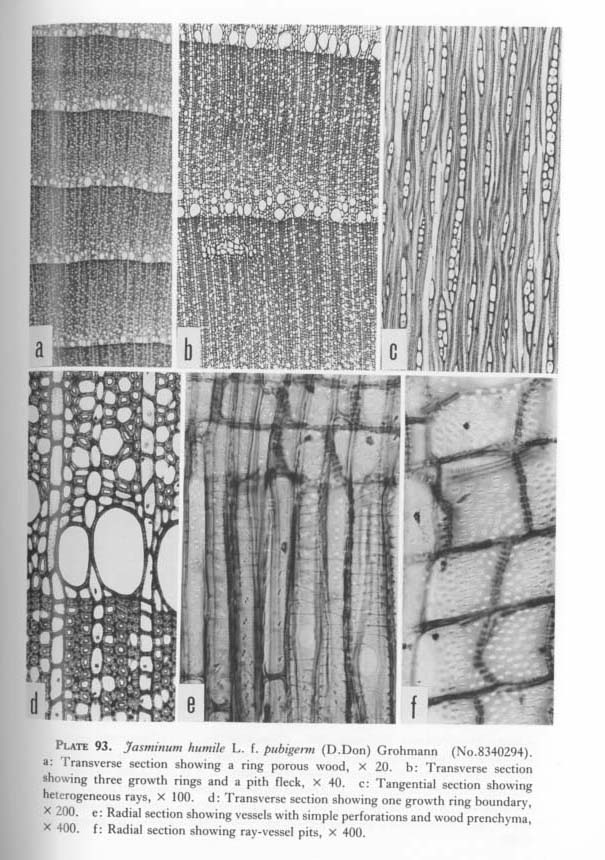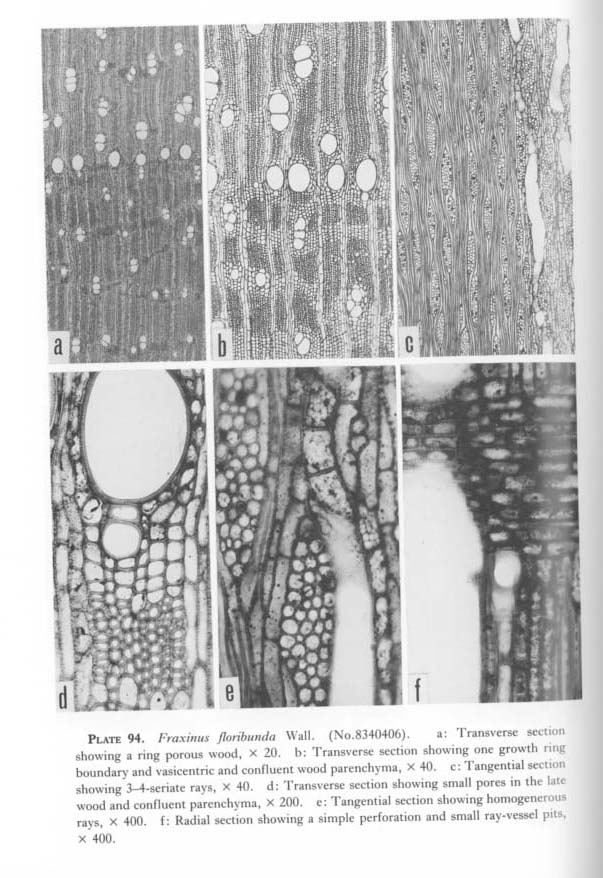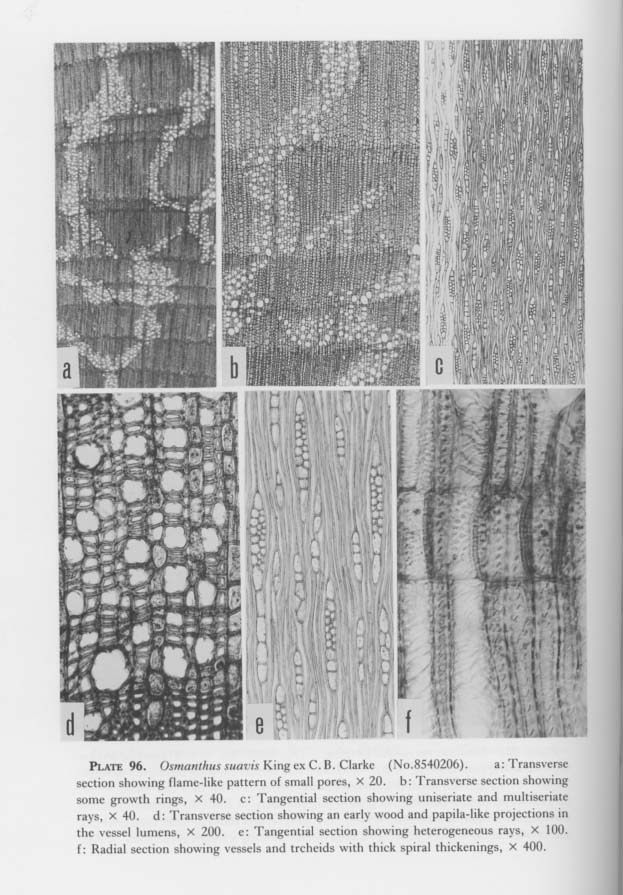WOOD STRUCTURE OF HIMALAYAN PLANTS
Mitsuo SUZUKI and Shuichi NOSHIRO
| ( 2 / 2 ) |
|
Rhododendron anthopogon D. Don [Plate 72]
A small evergreen shrub growing in the lower alpine zone. SPECIMEN. No. 8540170*, d=ca. 3cm, h=0.5m, alt. 3960m: around Baula Pokhari (3960 m), H. Ohba et al., July 10, 1985. DESCRIPTION. Wood is diffuse porous with very small pores and sometimes with discontinuous rings. Growth rings are present but quite obscure; usually one layer of flattened fiber tracheids at the terminal barely define the boundary of growth rings; width is fairly narrow (0.1-0.4 mm) and sometimes extremely narrow. Pores are evenly distributed with a tendency to be fewer and smaller in the initial zones of growth rings; tending to be solitary when compared with those in the outer portions of growth rings; solitary or in tangential multiple or in clusters; pores are uniform in size and very small, polygonal in outline, 12-33 and 10-25 µm in radial and tangential diameters respectively; with very thin walls (less than 1 µm in thickness). Vessel elements are fairly short (200-320 µm); perforation plates are small and exclusively scalariform with a little thick bars at narrow intervals, which sometimes become reticulate; bars not many, mostly 7-13. Intervessel pits are sparse and alternate; round or a little horizontally long-elliptical in outline (about 4 µm in horizontal diameter) with slit-like apertures. Spiral thickenings are restricted at the ligulate ends of vessel elements. Non-perforated tracheal elements are fiber tracheids. Fiber tracheids constitute the ground mass of wood; fairly small rectangular or polygonal in outline (6-18 and 8- 18 µm in radial and tangential diameters respectively); usually one layer of fiber tracheids becomes flattened (less than 5 µm in radial diameter) at the terminal of growth rings; walls fairly thin (less than 1.5 µm); bordered pits are sparsely arranged and very small with slit-like apertures; spiral thickenings are invisible. Wood parenchyma is diffuse; quite difficult to recognize in cross section because it is very similar to that of fiber tracheids; very thin-walled; crystals invisible. Rays are heterogeneous; mostly uniseriate and sometimes multiseriate. Uniseriate rays are very high and consist of wholly upright cells; mostly 1-15 cells and 30-360 µm and sometimes more in height. Multiseriate rays are mixed with uniseriate rays or aggregated in small groups of two to several rays; 3-5 cells wide (20-40 µm), and rather low (250-440 µm); made up of a multiseriate central core of procumbent cells and low uniseriate wings of square and upright cells; uniseriate wings usually have one or two cells. Upright and square cells are more or less slender elliptical or fusiform in tangential section; 25-65,7-15 and 15-35 µm in vertical, tangential and radial diameters respectively. Procumbent cells are oval or polygonal in tangential section; 6-18, 5-13 and 25-50 µm in vertical, tangential and radial diameters respectively. Crystals invisible in any ray cells. Ray-vessel pits are numerous and alternately dense; polygonal or horizontally long-elliptical with horizontally long slit-like apertures and narrow borders. Rhododendron arboreum Smith [Plate 73]
The most dominant tree from the upper temperate zone to the sub-alpine zone. It is a large evergreen tree (sometimes reaching to 100 cm in diameter and 30 m high) in the lower altitude and it becomes a small tree in the sub-alpine zone. SPECIMENS. No. 8340065, alt. 1960 m: Gandaki Zone, Pokhara Dist., Pathana (Dhampus, 2050 m)-Tolka (1850 m), H. Ohba et al., July 8, 1983. No. 8340142, d=50 cm, h= 15 m, alt. 2780 m: Dhaulagiri Zone, Parbat Dist., Banthand (2650 m)-Gorepani Deolari (3170 m), H. Ohba et al., July 12, 1983. No. 8340436*, d=20 cm, h=8 m, alt. 2200m: Rolwaling Khola, Simigaon (1950 m)-Sekpa (2300 m)-Kyalche (2700 m), H. Ohba et al., Aug. 31, 1983. DESCKIPTION. Wood is diffuse porous with small pores and sometimes with pith flecks. Growth rings are present but indistinct; the difference in pore size between the outermost late wood and the following early wood and flattened fiber tracheids at the terminal define the boundary of growth rings; width is variable sometimes with discontinuous rings (0.2-4.0 mm). Pores are abundant and evenly distributed without any specific patterns; solitary or in multiples with two to several pores in tangential or radial direction; pore size is reduced gently from the beginning to the end of the growth rings; 25-60 and 25-45 µm in radial and tangential diameters respectively in the early wood, while about 15 and 20 µm in radial and tangential diameters respectively in the smaller pores near the end of the growth rings; polygonal or rectangular in outline with thin walls (1,5-2.5 µm in thickness). Vessel elements are short (220-500 µm); perforation plates are exclusively scalariform with fine bars at a little wide intervals; mostly 8-20 bars; bars are more numerous and thick in the vessels at the end of growth rings. Intervessel pits are sometimes observed; arranged alternately with narrow spaces and small round (about 4µm in diameter) with slit-like apertures. Spiral thickenings are distinct on the entire inner walls. Non-perforated tracheal elements are fiber tracheids. Fiber tracheids constitute the ground mass of wood; polygonal or rectangular in outline (10-25 and 8-27 µm in radial and tangential diameters respectively), but become flattened at the terminal of growth rings (less than 6 µm in radial diameter); with a little thick walls (3-4 µm); bordered pits are quite similar to intervessel pits or a little smaller; fine spiral thickenings are present. Wood parenchyma is a little abundant; diffuse and diffuse-in-aggregate; size in cross section is quite similar to that of fiber tracheids; very thin-walled; crystals invisible. Rays are heterogeneous; uniseriate and multiseriate. Uniseriate rays consist entirely of upright or square cells; 1-16 cells and 60-800 µm or more in height. Multiseriate rays are 2-6, mostly 3-5 cells wide (3 0-80 µm) and 250-1250 µm or more in height; made up of a multiseriate central core of procumbent cells and uniseriate wings of square and upright cells; uniseriate wings are usually low, mostly with one or two cells, but sometimes become very high with four to eight or more cells. Upright and square cells are slender elliptical, fusiform or triangle in tangential section; 50-100, 10-25 and 20-55 µm in vertical, tangential and radial diameters respectively. Procumbent cells are oval or vertically long-elliptical in tangential section; 12-35, 10-25 and 30-150 µm in vertical, tangential and radial diameters respectively. Crystals are invisible in any ray cells. Ray-vessel pits are numerous and dense; arranged alternately; oval or horizontally long-elliptical with horizontally long slit-like apertures. Rhododendron arboreum Smith subsp. cinnamomeum (Wall. ex Lindl.) Tagg [Plate 74]
An evergreen tree growing mainly in the sub-alpine zone. SPECIMENS. No. 8340466, d=15 cm, h=6 m, alt, 2650m; No. 8340474, d=20cm, h=7 m, alt, 3150 m: Rolwaling Khola, Kyalche (2700 m)-Dongang (2650 m)-Thandingma (3200 m), H. Ohba et al., Sept. 1, 1983. No, 8340495*, d=25 cm, h=6 m, alt, 2930 m: Khare Khola, Patale Pokhari (4000 rn)-a pass (4200 m)-Phedi Kharka (2100 m), Ohba et al., Sept. 13, 1983. DESCRIPTION. Wood is diffuse porous with small pores and often with pith flecks. Growth rings are present but indistinct; one to several layers of flattened fiber tracheids at the terminal barely define the boundary of growth rings; 1.2-2.7 mm in width. Pores are abundant and evenly distributed without any specific pore patterns; solitary or in multiple with two to several pores in tangential or radial direction; polygonal in outline and quite uniform in size; 15-60 and 15-50µm in radial and tangential diameters respectively; with thin walls (about 1.2µm). Vessel elements are short (300- 500 µm); perforation plates are exclusively scalariform with fine bars at a little wide intervals; mostly 8-20 bars; bars are more numerous and thick in the vessels at the end of growth rings. Intervessel pits alternate with spaces and small round (4-5 µm in diameter) with slit-like apertures. Spiral thickenings are distinct on the entire inner walls. Non-perforated tracheal elements are fiber tracheids. Fiber tracheids constitute the ground mass of wood; polygonal or rectangular in outline (10-25 and 8-25 µm in radial and tangential diameters respectively), but become flattened at the terminal of growth rings (less than 6 µm in radial diameter); with rather thin walls (2-2.5 µm); bordered pits are quite similar to intervessel pits or a little smaller; fine spiral thickenings are present. Wood parenchyma is diffuse and diffuse-in-aggregate; size in cross section, is quite similar to that of fiber tracheids; very thin-walled; crystals invisible. Rays are heterogeneous; uniseriate and multiseriate. Uniseriate rays consist entirely of upright or square cells; 1-12 cells and 60-560 µm or more in height. Multiseriate rays are 2-6, mostly 3-5 cells wide (20-80 µm) and 250-850 µm or more in height; made up of a multiseriate central core of procumbent cells and uniseriate wings of square and upright cells; uniseriate wings are usually low often with one or two cells but sometimes lacking or very high with four to eight or more cells. Upright and square cells are slender elliptical, fusiform or triangle in tangential section; 30-90, 10-25 and 25-50 µm in vertical, tangential and radial diameters respectively. Procumbent cells are oval or vertically long-elliptical in tangential section; 10-30, 8-20 and 35-170 µm in vertical, tangential and radial diameters respectively, Crystals are invisible in any ray cells. Ray-vessel pits are numerous and dense; arranged alternately; oval or horizontally long-elliptical with horizontally long slit-like apertures. Rhododendron barbatum Wall. [Plate 75]
An evergreen tree growing from the upper temperate zone to the subalpine zone. SPECIMENS. No. 8340133*, d=20 cm, h=10 m, alt. 2700 m; No. 8340156, d=25 cm, h=8m,alt. 3120m: Dhaulagiri Zone, Parbat Dist., Banthanti (2650 m)-Gorepani Deolari (3170 m), H. Ohba et al., July 12, 1983. No. 8340481, d=18 cm, h=6 m, alt. 3240 m: Rolwaling Khola, Thandingma (3203 m)-Nimare (3450 m)-Beding (3600 m), H. Ohba et al., Sept. 2, 1983. No. 8340493, d=18 cm, h=6 m, alt. 3340m: Khare Khola, Patale Pokhari (4000 m)-a pass (4200 m)-Phedi Kharka (2100 m), Ohba et al., Sept. 13, 1983, No. 8540165, d= 15 cm, h=3.5 m, alt. 3450 m: Serdingma (3400 m)-Dubikharka (3720 m), H. Ohba et al., July 7,1985. No. 8540274, d=10 cm, h=3.5 m, alt. 3260 m: Pike Dongshar (3600 m)-Ngawur (3300m)-Goligaon (2900 m)-Namikhil (2300m), H. Ohba et al., Sept. 9, 1985. DESCRIPTION. Wood is diffuse porous with small pores and often with pith flecks. Growth rings are present but indistinct; the difference in pore size between the outer most late wood and the following early wood and the flattened fiber tracheids at the terminal define the boundary of growth rings; width is variable from fairly narrow to a little wide (0.1-2.9 mm). Pores are abundant and evenly distributed with some tendency to be in tangential multiples especially in the late wood; solitary or in a multiple with two to several pores; pore size is reduced gently from the beginning to the end of the growth rings; polygonal in outline, 10-60 and 15-50µm in radial and tangential diameters respectively; with thin walls (1-1.5 µm). Vessel elements are short (250-460µm); perforation plates are exclusively scalariform with a little thick bars at narrow to a little wide intervals; mostly 10-30 or more bars. Inter vessel pits alternate with round pits and are sometimes in scalariform with horizontally long pits; small round to horizontally long-elliptical (4-13 µm in horizontal diameter) with slit-like apertures. Spiral thickenings are distinct on the entire inner walls. Non-perforated tracheal elements are fiber tracheids. Fiber tracheids constitute the ground mass of wood; polygonal or rectangular in outline (8-25 and 12-22 µm radial and tangential diameters respectively), but become flattened at the terminal of growth rings (less than 5 µm in radial diameter); with rather thin walls (2-2.5 µm); bordered pits are sparsely arranged and small round with slit-like apertures; spiral thickenings are invisible. Wood parenchyma is diffuse and diffuse-in-aggregate; size in cross section is quite similar to that of fiber tracheids; very thin-walled; crystals invisible. Rays are heterogeneous; uniseriate and multiseriate. Uniseriate rays consist mostly of upright or square cells and sometimes from procumbent cells especially in higher rays; 1-10 cells and 60-370 µm or more in height. Multiseriate rays are 2-4, mostly 2 or 3 cells wide (20-50µm) and 200-750 µm or more in height; made up of a multiseriate central core of procumbent cells and uniseriate wings of square and upright cells; uniseriate wings are usually low often with one or two cells but sometimes become very high with four to nine or more cells. Upright and square cells are slender elliptical, fusiform or triangular in tangential section; 25-75, 10-20 and 20-50 µm in vertical, tangential and radial diameters respectively. Procumbent cells are oval or vertically long-elliptical in tangential section; 10-30, 6-22 and 50-160 µm in vertical, tangential and radial diameters respectively. Crystals are invisible in any ray cells. Ray-vessel pits are numerous and alternately dense and sometimes in scalariform; oval or horizontally long-elliptical with horizontally long slit-like apertures and narrow borders. Rhododendron campamdatum D. Don [Plate 76]
An evergreen tree growing from the upper temperate zone to the subalpine zone. SPECIMEN. No. 8540158*, d=20 cm, h =8 m, alt. 3250 m; Janakpur Zone, Dolakha Dist., Deolari (2700 m)-Thodung (3000 m)-Serdingma (3400 m), H. Ohba et al., July 6, 1985. DESCRIPTION. Wood is diffuse porous with small pores. Growth rings are present but indistinct; a little difference of pore size between the outermost late wood and the following early wood and flattened fiber tracheids at the terminal define the boundary of growth rings; width is fairly narrow (0.1-0.8 mm). Pores are abundant and evenly distributed without any tendency to be of a specific pore pattern; solitary or in tangential multiple with two to several pores; pore size is reduced gently from the beginning to the end of the growth rings; polygonal in outline, 15-55 and 15-40µm in radial and tangential diameters respectively; with very thin walls (less than 1 µm). Vessel elements are short (300-500 µm); perforation plates are exclusively scalariform with fine to a little thick bars at a little wide to narrow intervals; mostly 15-25 or more bars. Intervessel pits are observed mainly on the radial walls; sparse and alternate with round pits; small round (about 5 µm in diameter) with slit- like apertures. Spiral thickenings are present on the entire inner walls, especially distinct at the ligulate ends of vessel elements. Non-perforated tracheal elements are fiber tracheids. Fiber tracheids constitute the ground mass of wood; polygonal or rectangular in outline (8-20 and 10-20 µm in radial and tangential diameters respectively), but become flattened at the terminal of growth rings (less than 6 µm in radial diameter); with rather thin walls (about 2 µm); bordered pits are sparsely arranged and small round with slit-like apertures; spiral thickenings are invisible. Wood parenchyma is rather sparse and diffuse; size in cross section is quite similar to that of fiber tracheids; very thin-walled; crystals invisible. Rays are heterogeneous; uniseriate and multiseriate. Uniseriate rays consist mostly of upright or square cells; 1-7 cells and 40-330 µm or more in height. Multiseriate rays arc narrow, 2 or 3 cells wide (20-30µm), and low, 180-500 µm or more in height; made up of a multiseriate central core of procumbent cells and uniseriate wings of square and upright cells; uniseriate wings are usually low often with one or two cells but sometimes become high with four or more cells. Upright and square cells are slender elliptical, fusiform or triangular in tangential section; 35-75, 10-18 and 15-40µm in vertical, tangential and, radial diameters respectively. Procumbent cells are oval or vertically long-elliptical in tangential section; 10-25, 10-15 and 50-100 µm in vertical, tangential and radial diameters respectively. Crystals are invisible in any ray cells. Ray-vessel pits are numerous and alternately dense; polygonal or horizontally a little long-elliptical with horizontally long slit-like apertures and narrow borders. Rhododendron campanulatum D. Don var. wallichii (Hook. f.) Hook. f. [Plate 77]
An evergreen tree growing from the upper temperate zone to the sub-alpine zone. SPECIMENS. No. 8340469, d=12 cm, h=3 m, alt. 2790 m; Rolwaling Khola, Kyalche (2700 m)-Dongang (2650 m)-Thandingma (3200 m), H. Ohba et al., Sept. 1, 1983. No. 8340487*, d=20 cm, h=3 m, alt. 3650 m: Rolwaling Khola, Beding (3600 m)-Na (4050 m), H. Ohba et al., Sept. 4, 1983. DESCRIPTION. Wood is diffuse porous with small pores. Growth rings are present but indistinct; difference of pore size between the outermost late wood and the following early wood and several layers of flattened fiber tracheids at the terminal define the boundary of growth rings; width is a little wide (1.2-2.8 mm). Pores are abundant and evenly distributed without any tendency to a specific pore pattern; solitary or in small multiples or clusters with two to several pores; pore size is reduced gently from the beginning to the end of the growth rings; polygonal in outline; 15-60 and 15-52 µm in radial and tangential diameters respectively. Vessel elements are fairly short (150-320µm); perforation plates are exclusively scalariform with fine to a little thick bars at a little wide to narrow intervals; mostly 15-20 bars. Intervessel pits are arranged alternately with spaces; round to elliptical, small (about 5 µm in diameter) with slit-like apertures. Spiral thickenings are present on the entire inner walls, especially distinct at the ligulate ends of vessel elements. Non-perforated tracheal elements are fiber tracheids. Fiber tracheids constitute the ground mass of wood; polygonal or rectangular in outline (8-25 and 10-20 µm in radial and tangential diameters respectively), but become flattened at the terminal of growth rings (less than 6µm in radial diameter); with rather thin walls (about 1.5µm); bordered pits are sparsely arranged and small round with slit-like apertures; spiral thickenings are invisible. Wood parenchyma is rather sparse; diffuse and diffuse-in-aggregate; size in cross section is quite similar to that of fiber tracheids; very thin-walled; crystals invisible. Rays are heterogeneous; 1-4-seriate; consisting of upright, square and procumbent cells. Uniseriate rays consist mostly of upright or square cells and sometimes of procumbent cells; 1-17 cells and 30-400µm or more in height. Multiseriate rays are narrow, 22-45 µm in width, and rather low, 150-500 µm or more in height; made up of a multiseriate central core of procumbent cells and uniseriate wings of square and upright cells; uniseriate wings are usually low often, with one cell but sometimes become high with eight or more cells. Upright and square cells are elliptical, fusiform or triangular in tangential section; 25-53, 10-20 and 17-43 µm in vertical, tangential and radial diameters respectively. Procumbent cells are oval or vertically long-elliptical in tangential section; 10-25, 5-15 and 28-113 µm in vertical, tangential and radial diameters respectively. Crystals are invisible in any ray cells. Ray-vessel pits are numerous and alternately dense; polygonal or horizontally long-elliptical with horizontally long slit-like apertures and narrow borders. Rhododendron dalhonsiae Hok. f. [Plate 78]
An evergreen epiphytic shrub on big trees in the temperate zone. SPECIMEN. No. 8540118*, d=2 cm, h=2 m, on the trunk of Quercus semecarpifolia, alt. 2490 m: Kutumsang (2450 m)-Gul Bhanjyang (3410 m)-Pati Bhanjyang (1780 m), M. Suzuki & S. Noshiro, June 4, 1985. DESCRIPTION. Wood is diffuse porous with small pores. Growth rings are present but not distinct; the differences of pore size and pore density between the outermost late wood and the following early wood and several layers of flattened fiber tracheids at the terminal define the boundary of growth rings; very narrow to narrow, 0.05- 1.3 mm in width. Pores are fairly evenly distributed but more abundant in the early wood than in the late wood; mostly solitary and rather rarely in multiples with two to several pores in tangential or radial direction; pore size is reduced gently from the beginning to the end of the growth rings; 13-38 and 15-30 µm in radial and tangential diameters respectively in the early wood, while about 15 and 20 µm in radial and tangential diameters respectively in the smaller pores near the end of the growth rings; polygonal or rectangular in outline with thin walls (about 1.5µm in thickness). Vessel elements are a little long (350-550 µm); perforation plates are exclusively scalariform with fine bars at a little wide intervals; bars a little numerous (mostly 15-26 bars) and more numerous and thick in the vessels at the end of growth rings, Intervessel pits are arranged alternately with narrow spaces and small round (3-4µm in diameter) with slit-like apertures; sometimes tend to be arranged in scalariform. Spiral thickenings are restricted to the ligulate ends of vessel elements. Non-perforated tracheal elements are fiber tracheids. Fiber tracheids constitute the ground mass of wood; polygonal or rectangular in outline (8-25 and 8-25 µm in radial and tangential diameters respectively), but become flattened at the terminal of growth rings (less than 5 µm in radial diameter); with a little thick walls (2.5-3 µm); bordered pits are quite similar to intervessel pits or a little smaller than those; spiral thickenings are invisible. Wood parenchyma is a little abundant; diffuse and diffuse-in-aggregate; size in cross section is quite similar to that of fiber tracheids; very thin-walled; crystals invisible. Rays are heterogeneous; uniseriate and multiseriate. Uniseriate rays are consist entirely of upright cells; 1-12 cells and 40-700µm or more in height. Multiseriate rays are rather few and distributed evenly; rather narrow and not so high; 2-5 cells (25-50 µm) in width and 220-780 µm or more in height; made up of a multiseriate central core of procumbent cells and uniseriate wings of square and upright cells; uniseriate wings are usually low mostly with one or two cells but sometimes become fairly higher with several cells. Upright and square cells are slender elliptical, fusiform or triangular in tangential section; 35-75,8-25 and 12-35 µm in vertical, tangential and radial diameters respectively. Procumbent cells are oval or vertically long-elliptical in tangential section; 14-30, 12-30 and 35-87 µm in vertical, tangential and radial diameters respectively. Crystals are invisible in any ray cells. Ray-vessel pits are numerous and dense; arranged alternately; oval or horizontally long-elliptical with horizontally long slit-like apertures. Rhododendron hodgesonii Hook. f. [Plate 79]
An evergreen tree growing in the upper temperate zone and in the sub-alpine zone. SPECIMENS. No, 8540246*, d=18 cm, h=6 m, alt. 3560 m; No. 8540247; d=30 cm, h= 7 m, alt. 3560 m; Sarkari Pati (3350 m)-Ringmo (2700 m)-Phera (2500 m)-Beni (2350 m), H. Ohba et al., Sept. 3, 1985. DESCRIPTION. Wood is diffuse porous with very small pores and often with pith flecks. Growth rings are present but indistinct; several layers of flattened fiber tracheids at the terminal barely define the boundary of growth rings; width is fairly narrow (0.1-1.5 mm). Pores are abundant and evenly distributed; solitary or in tangential multiples with two to several pores; pores are uniform in size and small, polygonal in outline, 15-45 and 12-35 µm in radial and tangential diameters respectively; with very thin walls (less than 1 µm in thickness). Vessel elements are rather short (300-450 µm); perforation plates are exclusively scalariform with fine to a little thick bars at narrow intervals, and sometimes become reticulate; bars rather numerous, mostly 15-30 or more. Intervessel pits are found mainly on the radial walls; sparse and alternate; round or a little horizontally long-elliptical in outline (about 4 µm in horizontal diameter) with slit-like apertures. Spiral thickenings are distinct on the entire inner walls. Non-perforated tracheal elements are fiber tracheids. Fiber tracheids constitute the ground mass of wood; small rectangular or polygonal in outline (8-10 and 10-20 µm in radial and tangential diameters respectively), but become strongly flattened at the terminal of growth rings; walls rather thin (about 2 µm); bordered pits are sparsely arranged, small and round with slit-like apertures; spiral thickenings are invisible. Wood parenchyma is diffuse and diffuse-in-aggregate; size in cross section is quite similar to that of fiber tracheids; very thin-walled; crystals invisible. Rays are heterogeneous; uniseriate and multiseriate. Uniseriate rays mostly consist of upright or square cells; mostly 1-10 cells and 60-400 µm and sometimes up to 16 cells (710 µm) in height. Multiseriate are narrow, 2-4, mostly 2 or 3, cells wide (10-25µm), and low to a little high, 180-550 µm or more in height; made up of a multiseriate central core of procumbent cells and uniseriate wings of square and upright cells; uniseriate wings are usually low, often with one to two cells but sometimes become high with 5-8 or more cells. Upright and square cells are slender elliptical, fusiform or triangular in tangential section; 25-75, 8-20 and 20-40 µm in vertical, tangential and radial diameters respectively. Procumbent cells are oval or vertically long-elliptical in tangential section; 10-18, 8-16 and 45-100 µm in vertical, tangential and radial diameters respectively. Crystals are invisible in any ray cells. Ray-vessel pits are numerous and alternately dense; polygonal or horizontally long-elliptical with horizontally long slit-like apertures and narrow borders. Rhododendron lepidotum Wall. ex G. Don, 'forest form' [Plate 80]
A small evergreen shrub with a straight slender stem growing in the forests of the upper temperate zone. SPECIMEN. No. 8540037*, d=1.5 cm, h=about 1 m, alt. 2680 m: Bagmati Zone, Rasuwa Dist., Lama Hotel (2480 m)-Ghora Tabela (3000 m)-Langtang (3380 m), M. Suzuki & S. Noshiro, May 25, 1985. DESCRIPTION. Wood is diffuse porous with very small pores, pith flecks and occasional discontinuous rings. Growth rings are present but quite obscure; 1-3 layers of flattened fiber tracheids at the terminal barely define the boundary of growth rings; width is fairly narrow (0.1-1.0 mm). Pores are quite evenly distributed; mostly solitary and sometimes in small multiples with two or three pores; pores are quite uniform in size and very small, polygonal in outline, 12-25 and 12-20 µm in radial and tangential diameters respectively; with very thin walls (less than 1 µm in thickness). Vessel elements are rather short (180-320 µm); perforation plates are small and exclusively scalariform with a little thick bars at narrow intervals, and sometimes become reticulate; bars mostly 10-15. Intervessel pits are rarely observed on the radial walls; sparse and alternate; round or a little horizontally long-elliptical in outline (about 4 µm in horizontal diameter) with slit-like apertures. Spiral thickenings are faintly seen on the vessel walls while distinctly observed at the ligulate ends of vessel elements. Non-perforated tracheal elements are fiber tracheids. Fiber tracheids constitute the ground mass of wood; fairly small rectangular or polygonal in outline (6-18 and 8-15 µm in radial and tangential diameters respectively); become flattened at the terminal of growth, rings; walls fairly thin (less than about 1.5 µm); bordered pits are sparsely arranged, very small and round with slit-like apertures; spiral thickenings are invisible. Wood parenchyma is diffuse; quite difficult to recognize in cross section because its size in cross section is very similar to that of fiber tracheids; very thin-walled; crystals invisible. Rays are heterogeneous; mostly uniseriate; multiseriate rays are fairly few and mixed with uniseriate rays. Uniseriate rays are very high and constituted wholly of upright cells; mostly 1-13 cells and 50-470 µm and sometimes up to more in height. Multiseriate rays are rather rare; 2-5 cells and 12-40 µm in width and 180-630 µm or more in height; consisting of multiseriate central core of procumbent cells and uniseriate wings of square and upright cells; uniseriate wings often have many cells. Upright and square cells are quite slender elliptical or fusiform in tangential section; 20-50, 8-15 and 14-30 µm in vertical, tangential and radial diameters respectively. Procumbent cells are oval or elliptical in tangential section; 6-15, 6-15 and 26-60 µm in. vertical, tangential and radial diameters respectively. Crystals invisible in all ray cells. Rayvessel pits are numerous and alternately dense; polygonal or horizontally long-elliptical with horizontally long slit-like apertures and narrow borders. Rhododendron lepidotum Wall. ex G. Don, 'alpine form' [Plate 81]
A small evergreen shrub with squashed stems growing mainly in the lower alpine zone. SPECIMEN. No. 8540173*, d=1.5 cm, h=0.3 m, alt. 4040 m; Janakpur Zone, Ramechhap Dist., Baula Pokhari (3960 m)-a peak (4100 m)-Chhu Ningma (4040 m), H. Ohba et al., July 11, 1985. DESCRIPTION. Wood is diffuse porous with very small pores and pith flecks. Growth rings are present but quite obscure; only one layer of flattened fiber tracheids at the the terminal barely defines boundary of growth rings; width is fairly narrow (0.1- 0.7 mm). Pores are quite evenly distributed; mostly solitary and rarely in couples; pores are quite uniform in size and very small, polygonal in outline, 10-20 and 10-20 µm in radial and tangential diameters respectively; with very thin walls (less than 1 µm in thickness). Vessel elements are fairly short (150-300µm); perforation plates are small and exclusively scalariform with a little thick bars at narrow intervals, and sometimes become reticulate; bars are few, mostly 7-16. Intervessel pits are usually seen on the radial walls; sparse and alternate; round or horizontally long-elliptical in outline (about 4µm in horizontal diameter) with slit-like apertures. Spiral thickenings are restricted to the ligulate ends of vessel elements. Non-perforated tracheal elements are fiber tracheids. Fiber tracheids constitute the ground mass of wood; very small rectangular or polygonal in outline (5-12 and 5-15 µm in radial and tangential diameters respectively); become flattened at the terminal of growth rings; walls fairly thin (less than about 1.5µm); bordered pits are sparsely arranged, very small and round with slit-like apertures; spiral thickenings are invisible. Wood parenchyma is diffuse; very difficult to recognize in cross section because its size is quite similar to that of fiber tracheids; very thin-walled; crystals invisible. Rays are heterogeneous; mostly uniseriate; multiseriate rays are rather few and mixed with uniseriate rays. Uniseriate rays are very high and consist of upright and square cells; mostly 1-15 cells and 35-520 µm and sometimes up to more in height. Multiseriate rays are not abundant; in groups of several rays or mixed with the uniseriate rays except for disturbed portions of leaf or branch traces; a little wide and rather low; 3-5 cells and 22-50 µm in width and 170-470 µm or more in height; made up of a multiseriate central core of procumbent cells and uniseriate wings of square and upright cells; uniseriate wings are usually low, often with one or two cells. Upright and square cells are quite slender elliptical or fusiform in tangential section; 20-45, 10-15 and 15- 28 µm in vertical, tangential and radial diameters respectively. Procumbent cells are oval or polygonal in tangential section; 7-18, 7-18 and 25-40 µm in vertical, tangential and radial diameters respectively. Crystals are invisible in any ray cells. Ray-vessel pits are numerous and alternately dense; polygonal or horizontally long-elliptical with horizontally long slit-like apertures and narrow borders. Rhododendron setosum D. Don [Plate 82]
A small evergreen shrub growing in the lowest alpine zone. SPECIMEN. No. 8540193*, d=3 cm, h=1.2 m, alt. 3750 m: around Neju (3651 m), H. Ohba et al., Aug. 1, 1985. DESCRIPTION. Wood is diffuse porous with very small pores. Growth rings are present but quite obscure; 1-3 layers of flattened fiber tracheids at the terminal barely define the boundary of growth rings; width is fairly narrow (0.05-0.4 mm) and sometimes extremely narrow. Pores are quite evenly distributed; mostly solitary and sometimes in multiple with two or three pores; uniform in size and very small, polygonal in outline, 10-25 and 10- 20 µm in radial and tangential diameters respectively; with very thin walls (less than 1 iµm in thickness). Vessel elements are rather short (300-450 µm); perforation, plates are small and exclusively scalariform with a little thick bars at narrow intervals, and sometimes become reticulate; bars mostly 12-20. Intervessel pits are observed mainly on the radial walls; sparse and alternate; round or horizontally long-elliptical in outline (about 4 µm in horizontal diameter) with slit-like apertures, Spiral thickenings are present but not so distinct, while distinct at the ligulate ends of vessel elements. Non-perforated tracheal elements are fiber tracheids. Fiber tracheids constitute the ground mass of wood; fairly small rectangular or polygonal in outline (6-15 and 8-18 µm in radial and tangential diameters respectively); become flattened at the terminal of growth rings; walls fairly thin (less than 1.5 µm); bordered pits are sparsely arranged, very small and round with slit-like apertures; spiral thickenings are invisible. Wood parenchyma is diffuse; quite difficult to recognize in cross section because its size is quite similar to that of fiber tracheids; very thin-walled; crystals invisible. Rays are heterogeneous; mostly uniseriate and rarely multiseriate. Uniseriate rays are very high and consist wholly of upright cells; mostly 1-17 cells and 45-750 µm and sometimes up to more in height. Multiseriate rays are rarely present except in the portions disturbed by leaf or branch traces; narrow, mostly 2-4 cells wide (15-50 µm), and rather low, 350-500 µm in height; made up of a multiseriate central core of procumbent cells and uniseriate wings of square and upright cells; uniseriate wings often have many cells. Upright and square cells are quite slender elliptical or fusiform in tangential section; 25-75, 7-12 and 12-35 µm in vertical, tangential and radial diameters respectively. Procumbent cells are oval or polygonal in tangential section; 8-20, 6-15 and 20-50 µm in vertical, tangential and radial diameters respectively. Crystals are invisible in any ray cells. Ray-vessel pits are numerous and alternately dense; poly- gonal or horizontally a little long-elliptical with horizontally long slit-like apertures and narrow borders. Rhododendron triflorum Hook. f. [Plate 83]
A small tree growing in the upper temperate zone. SPECIMEN. No. 8540242*, d=7 cm, h=2.5 m, alt, 2710m: Taktor (3000 m)-Junbesi (2650 m)-Mopung (2800 m), H. Ohba et al., Aug. 20, 1985. DESCRIPTION. Wood is diffuse porous with very small pores and often with pith flecks. Growth rings are present but only faintly distinct; one or two layers of flattened fiber tracheids at the terminal barely define the boundary of growth rings; width is fairly narrow (0.1-1.6 mm). Pores are abundant and quite evenly distributed without any tendency to be in a specific pattern; solitary or in tangential multiples with two to several pores; pores are uniform in size and fairly small, polygonal in outline, 15-45 and 12-35 µm in radial and tangential diameters respectively; with very thin walls (less than 1 µm). Vessel elements are short (230-350 µm); perforation plates are exclusively scalariform with fine to fairly thick bars at a little wide to very narrow intervals, and sometimes become reticulate; bars not so many, mostly 7-15 or more. Intervessel pits are observed mainly on the radial walls; sparse and alternate; round or a little horizontally long-elliptical in outline (5-8 µm in horizontal diameter) with slit-like apertures, Spiral thickenings are distinct on the entire inner walls. Non-perforated tracheal elements are fiber tracheids. Fiber tracheids constitute the ground mass of wood; small rectangular or polygonal in outline (8-15 and 8-20µm in radial and tangential diameters respectively), but become strongly flattened at the terminal of growth rings; walls a little thick (2.5-3µm); bordered pits are sparsely arranged and round with slit-like apertures; spiral thickenings arc invisible. Wood parenchyma is rather sparse and diffuse; size in cross section is quite similar to that of fiber tracheids; very thin-walled; crystals invisible. Rays are heterogeneous; uniseriate and multiseriate, Uniseriate rays are constituted mostly of upright or square cells; 1-8 cells and 60-380 µm or more in height. Multiseriate rays are rather narrow, 2-4, mostly 2 or 3, cells wide (25-35 µm), and rather low to a little high, 230-600 µm or more in height; made up of a multiseriate central core of procumbent cells and uniseriate wings of square and upright cells; uniseriate wings are usually low often with one or two cells but sometimes become high with 3-5 or more cells. Upright and square cells are slender elliptical, fusiform or triangular in tangential section; 37-75, 10-18 and 17-38 µm in vertical, tangential and radial diameters respectively. Procumbent cells are oval or vertically long-elliptical in tangential section; 12- 23, 8-15 and 45-90 µm in vertical, tangential and radial diameters respectively. Crystals are invisible in any ray cells. Ray-vessel pits are numerous and densely pitted alternately ; polygonal or horizontally long-elliptical withh orizontally long slit-like apertures and narrow borders.
|
